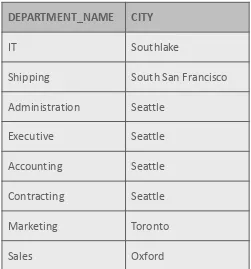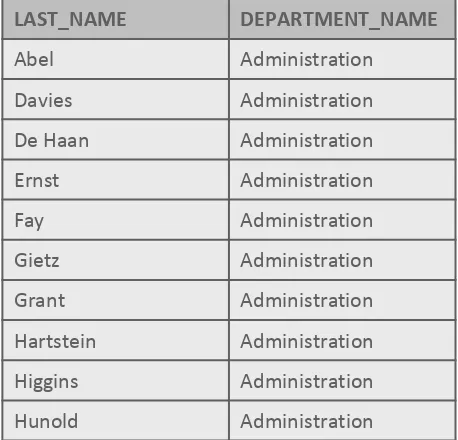Database Programming with SQL
6-1Objectives
This lesson covers the following objectives:
• Construct and execute a natural join using ANSI-99 SQL join
syntax
• Create a cross join using ANSI-99 SQL join syntax
• Explain the importance of having a standard for SQL as
defined by ANSI
• Describe a business need for combining information from
• Up to now, your experience using SQL has been limited to querying and returning information from one database table at a time.
• This would not be a problem if all
data in the database were stored in only one table.
Purpose
DEPARTMENT_ID DEPT_NAME LOCATION_ID
10 Administration 1700
20 Marketing 1800
…
110 Accounting 1700
190 Contracting 1700
EMPLOYEE_ID LAST_NAME DEPT_ID
100 King 90
101 Kochhar 90
…
202 Fay 20
205 Higgins 110
206 Gietz 110
EMPLOYEE_ID DEPT_ID DEPT_NAME
200 10 Administration 201 20 Marketing 202 20 Marketing …
102 90 Executive 205 110 Accounting 206 110 Accounting
EMPLOYEES DEPARTMENTS
• But you know from data modeling that separating data into
individual tables and being able to associate the tables with one another is the heart of relational database design.
Purpose
DEPARTMENT_ID DEPT_NAME LOCATION_ID
10 Administration 1700
20 Marketing 1800
…
110 Accounting 1700
190 Contracting 1700
EMPLOYEE_ID LAST_NAME DEPT_ID
100 King 90
101 Kochhar 90
…
202 Fay 20
205 Higgins 110
206 Gietz 110
EMPLOYEE_ID DEPT_ID DEPT_NAME
200 10 Administration 201 20 Marketing 202 20 Marketing …
102 90 Executive 205 110 Accounting 206 110 Accounting
EMPLOYEES DEPARTMENTS
• Fortunately, SQL provides join conditions that enable
information to be queried from separate tables and combined in one report.
Purpose
DEPARTMENT_ID DEPT_NAME LOCATION_ID
10 Administration 1700
20 Marketing 1800
…
110 Accounting 1700
190 Contracting 1700
EMPLOYEE_ID LAST_NAME DEPT_ID
100 King 90
101 Kochhar 90
…
202 Fay 20
205 Higgins 110
206 Gietz 110
EMPLOYEE_ID DEPT_ID DEPT_NAME
200 10 Administration 201 20 Marketing 202 20 Marketing …
102 90 Executive 205 110 Accounting 206 110 Accounting
EMPLOYEES DEPARTMENTS
Join Commands
• There are two sets of commands or syntax which can be used
to make connections between tables in a database:
– Oracle proprietary joins
– ANSI/ISO SQL 99 compliant standard joins
• In this course, you will learn to use both sets of join
commands.
ANSI
• ANSI stands for American National Standards Institute.
• Founded in 1918, ANSI is a private, non-profit organization
that administers and coordinates the U.S. voluntary standardization and conformity assessment system.
• The Institute's mission is to enhance both the global
competitiveness of U.S. business and the U.S. quality of life by promoting and facilitating voluntary consensus standards and conformity assessment systems, and safeguarding their
SQL
• Structured Query Language (SQL) is the
information-processing industry-standard language of relational database management systems (RDBMS).
• The language was originally designed by IBM in the mid
1970s, came into widespread use in the early 1980s, and
SQL
• So far there have been three ANSI standardizations of SQL,
each one building on the previous one.
• They are named after the year in which they were first
NATURAL JOIN
• A SQL join clause combines fields from 2 (or more) tables in a
relational database.
• A natural join is based on all columns in two tables that have
NATURAL JOIN
EMPLOYEE_ID LAST_NAME JOB_ID
100 King AD_PRES
101 Kochhar AD_VP
…
202 Fay MK_REP
205 Higgins AC_MGR
206 Gietz AC_ACCOUNT
• The employees table has a job_id column.
• This is a reference to the column of the same name in the
jobs table.
JOB_ID JOB_TITLE
AD_PRES President
AD_VP Administration Vice President
AD_ASST Administration Assistant
AC_MGR Accounting Manager
AC_ACCOUNT Public Accountant
SA_MAN Sales Manager
NATURAL JOIN
• As shown in the sample code, when using a natural join, it is
possible to join the tables without having to explicitly specify the columns in the corresponding table.
• However, the names and data types of both columns must be
the same.
• This join will return columns from the employees table and
their related job_title from the jobs table based on the common column job_id.
SELECT first_name, last_name, job_id, job_title FROM employees NATURAL JOIN jobs
NATURAL JOIN
SELECT first_name, last_name, job_id, job_title FROM employees NATURAL JOIN jobs
WHERE department_id > 80;
FIRST_NAME LAST_NAME JOB_ID JOB_TITLE
William Gietz AC_ACCOUNT Public Accountant
Shelley Higgins AC_MGR Accounting Manager
Steven King AD_PRES President
Neena Kochhar AD_VP Administration Vice President
NATURAL JOIN
• Here is another example:
• The departments and locations
table both have a column,
location_id, which is used to join the two tables.
• Notice that the natural join
column does not have to appear in the SELECT clause.
SELECT department_name, city
FROM departments NATURAL JOIN locations;
DEPARTMENT_NAME CITY
IT Southlake
Shipping South San Francisco
Administration Seattle
Executive Seattle
Accounting Seattle
Contracting Seattle
Marketing Toronto
CROSS JOIN
• The ANSI/ISO SQL: 1999 SQL CROSS JOIN joins each row in
one table to every row in the other table.
• The result set represents all possible row combinations from
the two tables.
• This could potentially be very large!
• If you CROSS JOIN a table with 20 rows with a table with 100
Cross Join Example
• The employees table contains 20 rows and the departments
table has 8 rows.
• Performing a CROSS JOIN will return 160 rows.
SELECT last_name, department_name
FROM employees CROSS JOIN departments;
LAST_NAME DEPARTMENT_NAME
Terminology
Key terms used in this lesson included:
• Cross join
Summary
In this lesson, you should have learned how to:
• Construct and execute a natural join using ANSI-99 SQL join
syntax
• Create a cross join using ANSI-99 SQL join syntax
• Explain the importance of having a standard for SQL as
defined by ANSI
• Describe a business need for combining information from

